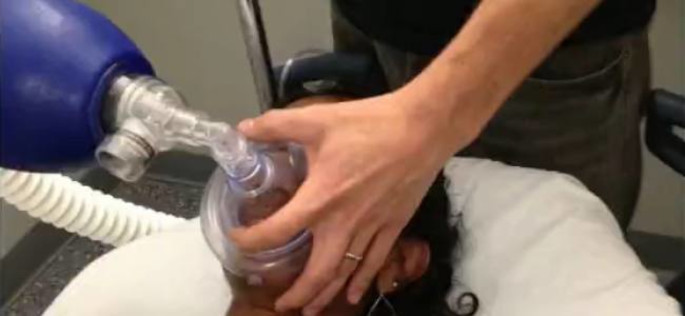
Ultrasound & Clinical Practice: how it helps in case of airway complications
According to three real clinical prehospital scenarios, let us see how ultrasound had been extremely useful to paramedics in order to understand what to do and to reach a positive outcome in case of airway complications.
These are three real scenarios in which we will see how ultrasound can be really useful and lifesaving in case of emergencies with airway complications.
How ultrasound help in case of airway complications: case 1
An allegedly 45 years old female was found unconscious in a secondary street by some people who were accidentally passing by. When the first medical team arrived, no one knew information about the patient.
She was unconscious with non coordinated vocal response, when stimulated, and no finalized movements of the extremities. She was spontaneously breathing with an apparent good respiratory drive a RR of 24 and O2 sat of 98% on room air. She had a bilaterally good palpable radial pulse, the HR was 72 and her BP 110 over 70. Her face and the anterior part of her chest presented multiple minor signs of trauma, but no sign of exsternal bleeding. Police was investigating, but they still have not found relevant clues.
The patient was not conscious and her respiration was weak. I decided to protect her airways with tracheal intubation. But first to proceed to RSI, during the preox period and despite the apparent hemodynamic stability, I decided to perform an extended FAST ultrasound exam.
Two minutes. The EFAST revealed a pneumothorax on the left, no abdominal bleeding, no pericardial fluid effusion. At this point we decide to open the chest (finger bougie tecnique, Ketamin pre-medication) before intubating the patient in prevision of the mechanical positive pressure ventilation, and air transport. The patient arrived well compensated (from both respiratory and hemodynamic point of view) at the trauma center where was discharged 3 weeks later without major clinical consequences.
In this case the chance to find clear US signs of penumothorax, prevented a possible worsening of respiratory and hemodynamic status after intubation. Intubation itself, PPV and high altiutde transport, are all factors that can precipitate a prior stable pneumothorax.
How ultrasound help in case of airway complications: case 2
The victim is a 28-year-old male, who has been extricated by firefighters in a car accident. When the fire crew arrived, he was still breathing but when the first medical crew arrived found him in CA. they started advanced life support, which was still ongoing when we arrived.
The patient was intubated (two thoracic tubes were bilaterally placed, emo-thorax on the right side no pneumo bilaterally and a bolus of 2 liters of fluids administered via two large bore venous accesses). He had an organized cardiac electric activity and an EtCO2 value of 35 mmHg (without chest compressions in place).
The US of the heart shown some weak wall motion (coordinated with electric activity), so we decided to rapidly transport the patient to the nearest trauma center where he was reanimated for more than 1 hour and then called without any evidence of possible cause of death.
Ultrasound can be a further hint in the decision to carry on the resuscitative efforts in patients in CA with PEA and no evidence of reversible causes on the field. It can be also the decisive tool in deciding to transport those patients to the hospital for second level diagnostic assessment and advanced care.
How ultrasound help in case of airway complications: case 3
This time the protagonist is a 24 years old pedestrian male, who has been hit by a motorbike while crossing the road. First responders found him unconscious. When we arrived, the patient was lying down on the spinal board wearing a cervical collar with eyes closed, but responsive when called and able to make simple commands.
He suffered a severe facial trauma with avulsion of several frontal teeth and a profound total tickness wound to the superior lip with presence of a lot of blood in the mouth and the first part of the airways. His breathing was laborious and noisy.
However, the patient was able to maintain an ox sat of 93% on room air (that easily improved to 98% with 2 liters of oxygen administered via simple O2 mask). The radial pulse was present at a rate of 90/min and the BP was 100 over 70. The rest of external exam highlighted a profound wound at the internal part of the calf with exposition of muscular plan and some hemorrhage well controlled with external manual compression.
We provided (with not much success due to the unstoppable bleeding) to clear the airways from blood and secretions, but still the respiration was difficult and noisy even if the ox sat was on a satisfying 98% on O2 non rebreather mask.
In the meanwhile two large bore venous accesses were placed and some fluids keep going. The EFAST exam revealed no signs of pneumo but presence of blood in the right and left upper quadrant of the abdomen. We did not insist further on airways control because at this point the control of abdominal bleeding became the first priority. After a rapid transport in ED the total body CT (he was still hemodynamically compensated) confirmed the presence of internal bleeding and the patient proceeded straight to OR.
Often the suspect of internal bleeding is not clear just by considering clinical signs, especially when we have to deal with young patients who have a large compensation range. POCUS can give us the chance to see the presence of blood in the abdomen and to prioritize our clinical pathway pondering these findings.
READ ALSO
Prehospital Airway Management: systematic review protocol
A COVID-19 patient 'resurrection'. From Campus Covid Center, an incredible case…
Source: MEDEST


